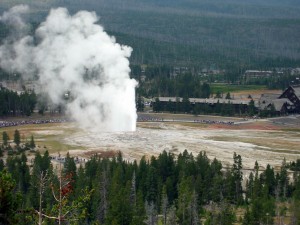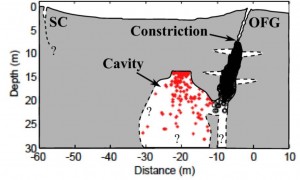12 April 2013
Newfound chamber below Old Faithful may drive eruptions
Posted by mcadams

Scientist have found a chamber beneath Old Faithful that might help fuel its predictable eruptions. Photo by Barbara Richman, American Geophysical Union.
By Sarah Charley
A previously unknown underground cavity might help trigger the timely eruptions of the famous Yellowstone geyser Old Faithful, a new study shows. The researchers who uncovered new evidence of a chamber suspect that it stores the pressurized near-boiling water, steam, and other gases that propel Old Faithful’s eruptions.
“The first model of geysers made by early explorers one century ago showed a cavity, but no one was able to find the cavity or prove that it existed,” said Jean Vandemeulebrouck of the Université de Savoie in Le Bourget du Lac, France.
Since then, scientists who first studied Old Faithful concluded that the narrowing of a subterranean passage through which the geyser’s searing fluids pass “was enough to provoke the choked flow and produce a regular eruption,” said Vandemeulebrouck, a hydrothermal systems researcher in Savoie’s Institut des Sciences de la Terre who led the new investigation.
But within the last year, new evidence of geyser-associated cavities turning up in several studies, including this one, has prompted scientists to re-evaluate their understanding of geysers and modify their models to include subterranean reservoirs that store the pressurized steam and gas that fuels the eruptions, Vandemeulebrouck explained.
Now with fresh signs that a cavity may be present beneath Old Faithful, Vandemeulebrouck and his colleagues speculate that this cavity might act as such a reservoir, or bubble chamber, where the roiling, sulfurous brew that becomes the geyser accumulates and builds up pressure.
The researchers discovered the cavity after reprocessing old seismic data and locating the origin of previously overlooked subterranean shaking. The results are to be published in Geophysical Research letters –a publication of the American Geophysical Union.
Because experiments are no longer allowed at Old Faithful, Vandemeulebrouck and his colleagues re-analyzed 3 hours of seismic recordings taken by seismologist Sharon Kedar in 1992 as part of his PhD research.
“We used a technique that was originally developed to locate sources of sound in the ocean,” Vandemeulebrouck said. “The cavity was revealed piece by piece—one tremor at a time,” he noted.
Inside Old Faithful’s underground plumbing, ground water is continually boiling and bubbling, producing tiny tremors that shake the surrounding earth. By analyzing the intensity and arrival times of these tremors at 96 seismic sensors located around the geyser, Vandemeulebrouck and his colleagues were able to reconstruct where each tremor originated.

This image by researchers studying Old Faithful shows the estimated shape of a subterranean cavity beneath the geyser.
As they did so, they found that many bubble-triggered tremors did not originate in Old Faithful’s main channel. Instead, they arose from an underground zone located between Old Faithful Geyser and Split Cone, a weakly active geyser to the southwest, indicating that there is a hollow chamber there, some 10 meters in diameter, holding bubbling water. Gas bubbles in the cavity apparently explode as they collide with the roof and walls, generating the small amounts of seismic activity that the research team interpreted to reconstruct the cavity’s shape and location.
Vandemeulebrouck explains that volcanic activity below the geyser vaporizes groundwater and turns it into steam, which then rises through underground channels toward the surface. Cooler condensed water near the surface blocks the steam’s escape and pushes it back down, creating a pressurized system.
“Geysers function like a mass on a spring,” Vandemeulebrouck said. “The water in the upper part of the conduit is the mass pushing down, and the hot steam is the spring, pushing up.”
The interplay between a growing weight of water and the increasing pressure of the ultra-hot pressurized steam pushes the surface water up and down, Vandemeulebrouck said. Eventually, some of the water escapes through the geyser, which reduces the pressure and allows the steam to rapidly expand, triggering an eruption.
When scientists first studied Old Faithful in the late 1980s and 1990s, they suspected that the complex structure of the main channel was sufficient to account for the geyser’s eruptions. But other recent research shows that geysers need large amounts of pressurized steam, gas and water to fuel the spray of water—and that the storage space in the main channel might not be enough.
Last September, a California study showed that heated groundwater stored in underground reservoirs 42 meters below the surface of a geyser provided the fire-power necessary to propel the geyser’s eruptions.
Russian scientists also recently filmed the inner plumbing of four geysers in Kamchatka by lowering video cameras into the geysers’ mouths. Inside, their films showed, bubbling horizontal channels branched off of the main conduits—leading them to believe that these channels connect the main conduits of the geysers they studied to gas-and-steam-filled bubble chambers.
Vandemeulebrouck suspects that the cavity he and his team discovered below Old Faithful plays a large role in propelling the geyser’s eruptions and is further evidence supporting the existence of subterranean bubble chambers that fuel geyser eruptions.
— Sarah Charley is AGU’s science writing intern


 GeoSpace is a blog on Earth and space science, managed by AGU’s Public Information staff. The blog features posts by AGU writers and guest contributors on all sorts of relevant science topics, but with a focus on new research and geo and space sciences-related stories that are currently in the news.
GeoSpace is a blog on Earth and space science, managed by AGU’s Public Information staff. The blog features posts by AGU writers and guest contributors on all sorts of relevant science topics, but with a focus on new research and geo and space sciences-related stories that are currently in the news.